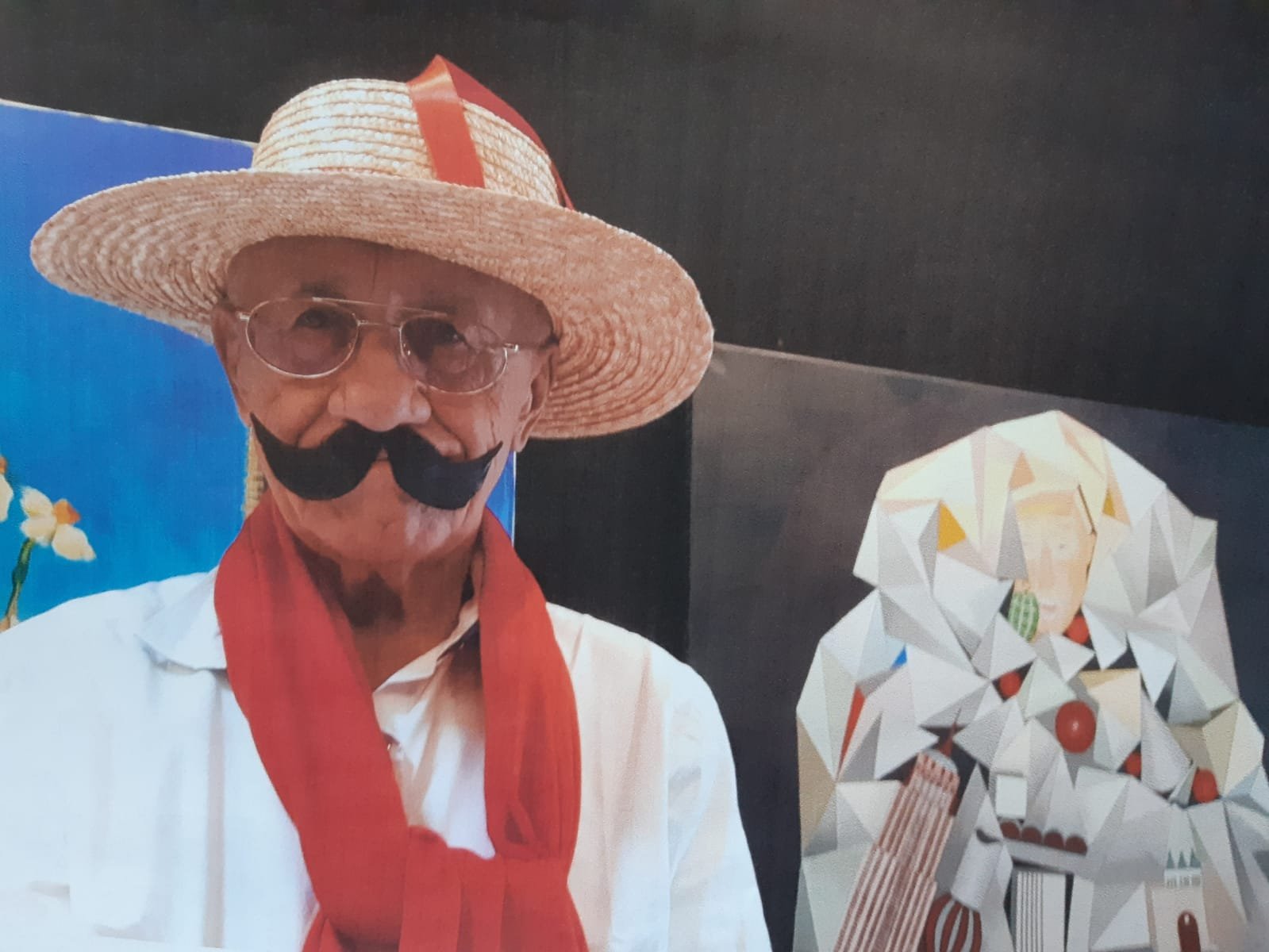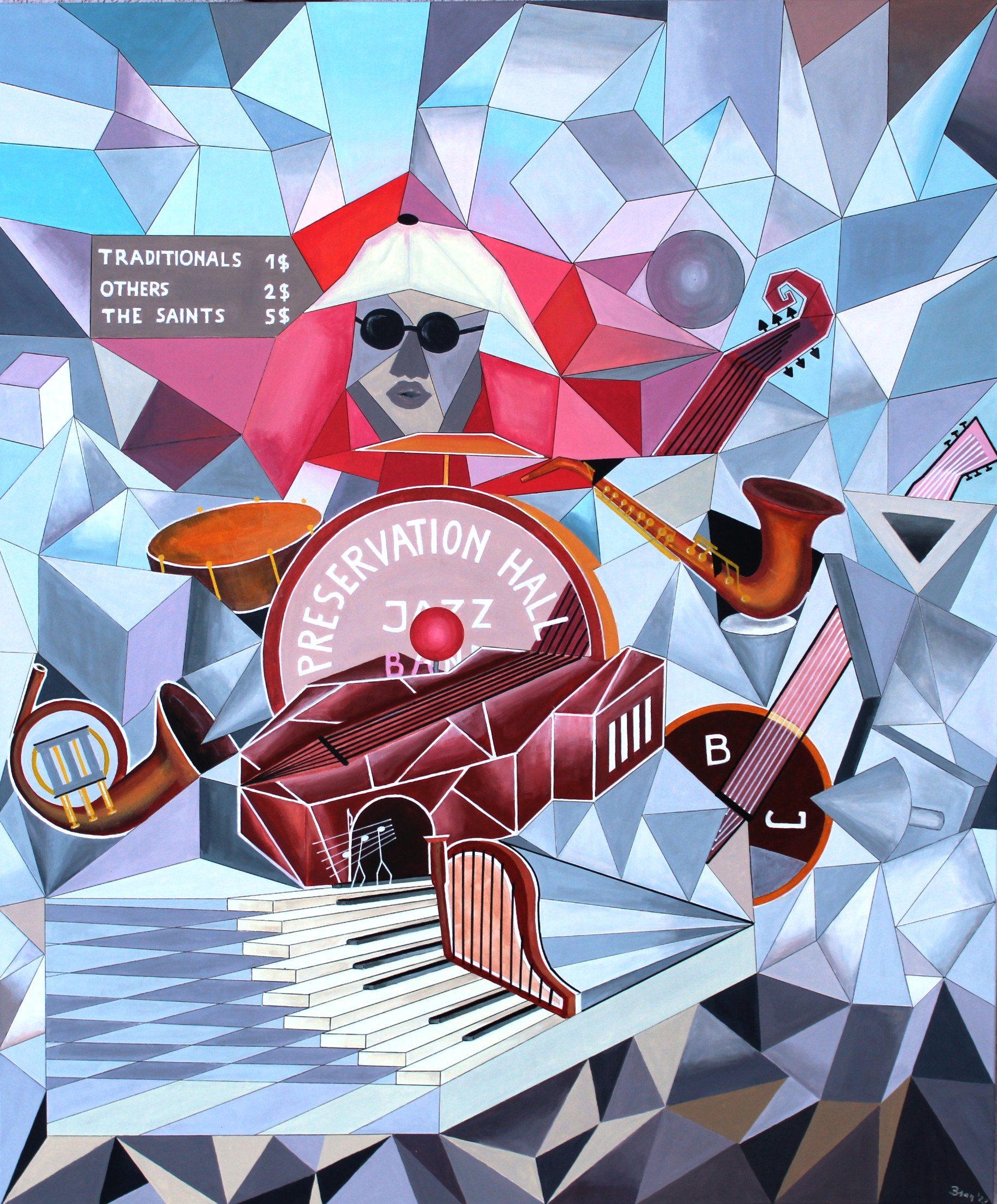10 Questions with Alex Bonsanthy
Bonsanthy started to study cybernetics and electronic engineering at the University of Bucharest, Romania, and finished with a Ph.D. degree at the University of Bremen in Germany. He also absolved a bundle of art lessons in the private Art School in Bucharest named Rembrandt. He is more a self-made artist.
But he considers himself to be a late disciple of Van Gogh and an unofficial bastard of Picasso. He likes the impression of colors and forms in either realistic or abstract paintings. His artworks should transmit magic and creative energy using expressive colors and forms.
His own invented style is Geometric Cubism. This is a more geometric emphasized Cubism, connecting the geometric lines of the modern world with artistic forms and colors.
The message transmitted by the Geometric Cubism is of equilibrium between forms created by humans and Nature. The beauty of the colors should be an expression of the natural influence on artificial constructions. It should be a link between Humanity and Nature.
Bonsanthy participated in the past at several international painting contests reaching the finalists level and being the winner of the 59th IInternational Contest of Artavita . His artworks were selected for art catalogs in England and Monaco. In 2021 he was selected to participate in the London Art Biennale. He has had two solo exhibitions up to now: 1) A virtual exhibition at Artavita in the year 2020 and 2)The solo exhibition “Die Raben von Rabenstein” in the Rabenstein Castle in Bavaria, Germany, in 2023.
Alex Bonsanthy - Portrait
ARTIST STATEMENT
For our society, dominated by consumer stress and the stress of fulfilling social media norms, art is a place of relaxation through contemplation and meditation. Social Media and AI intend to automatize our tastes, our norms of beauty, our designs, our behavior, and our feelings. These two modern tools are based on searching the past human experience, creating statistics and average behaviors, and elaborating following guidelines for modern art:
Use forms and colors that impressed most people to know
Art is valued based on sales results
Increase the value of art and artists through marketing actions
Use Art for Marketing and Sales
Use bold statements with vibrant colors and harsh contrasts for ads
Individual handmade Art is stopping the stress of this trend, of this must. The spirit is free to create based on feelings and new ideas, ignoring norms, trends, and sales standards. Let’s call it Free Art.
Free Art is quite subjective. It is not dominated by technology tools and expresses the feeling and the view of the artist. It is not a photography of reality. It is a subjective interpretation. It is not based on evaluations of the past artworks; it should create something new. The expression ‘Something New’ is the most important characteristic of Free Art. It should give us the possibility to discover new aspects of life and nature, to admire new colour combinations, and to trigger our imagination.
Bonsanthy is a fan of Free Art. Geometry is the part of mathematics that describes the natural lines and forms in a rigorous way. Geometry is a method to abstract the forms and lines of reality. Geometric Cubism is a more geometric emphasized cubism, keeping an artistic message. It should have a decorative function with a message of the view and feelings of the artist. The forms, lines, and colours should create something new that impresses the spectator of the artwork. It should excite his imagination giving him the satisfaction of seeing something nice and worthful.
Winter Flowers, Acrylic on canvas , 120x100 cm, 2022 © Alex Bonsanthy
INTERVIEW
First of all, you come from an engineering background. When did you first decide to become an artist? And what inspired you to pursue this career?
After gaining financial stability and more time to meditate, I decided to dedicate myself to my early passion: a life as an artist. Observing the evolution of the world, I felt the necessity to express my artistic ideas based on my large past experience. This happened ten years ago when I decided to use painting art to communicate my feelings in pictures and colors.
What is your personal aim as an artist? And how has it evolved over the years?
Due to the fact that I like the beautiful side of life, my aim is to influence young people to relax by observing the nice aspects of their life and of the surrounding world. Over the years, I understood that painting art could be used to make people more sensible about the beautiful aspects of the natural world. My artistic aim is to combine the artificial creations of humanity, the models, with natural lines and colors.
Acvatic Life, Encaustic Medium, 100x80 cm, 2022 © Alex Bonsanthy
Industrial Dog ,Acrylic on Canvas frame, 80x80 cm, 2022 © Alex Bonsanthy
You already have a long career. How would you define yourself as an artist?
In my opinion, an artist should try to influence other people in a positive way: to reduce stress by admiring nice artworks, to learn to use colors and forms in expressing their personality, to understand the positive messages of the artists, to understand hidden aspects of the life, to be more interested in the environment they use to work and live. My aim is to show to other people how the actual artificial human creations can be connected and trimmed to fit into the natural creations of the universe.
You have an interesting background and career with many different experiences. Does it influence your work? And where else do you get inspiration from for your work?
There is no doubt: my technical background is influencing my artwork. I like to express often my feelings in lines and geometrical forms. I learned a lot from the masters of Cubism: Picasso and Braque. I learned that it is possible to transmit ideas and feelings by distributing reality on different geometrical figures. These famous painters succeeded in transforming reality into connected distributed figures resulting in very exciting decorative artworks. The combination of colors and lines plays an essential role in creating the artistic effects of geometric cubist artworks.
What is your creative process like? And how did you evolve this way of working?
People are often asking this question. My artworks are distributed over three main styles: magic realism, geometric Cubism, and abstract. This diversity justifies this question. The answer is quite simple: I observe very intensively the world surrounding me. I'm interested in the evolution of artificial intelligence in art, technique, and science. I'm observing its effects on humanity. I'm observing the change in the world order and of the human mentality. I'm observing the change in the political leaders. This continuous observation is pushing me to send messages through my artwork. Even abstract artworks can express a message. The message is how to combine different colors or forms in order to have a decorative effect. Abstract works also stimulate the imagination.
The Godess of Piano, Oil on Canvas, 60x80 cm, 2021 © Alex Bonsanthy
You define your style as Geometric Cubism. Can you tell us more about it? And what aspect of your work do you pay particular attention to?
Geometric Cubism is a further development of the Classical Cubism. It uses more geometrical forms. But the more geometrical forms are used, the more difficult it is to describe the real world with them. But considering that the real world often consists of geometrical forms, my aim is to extract such geometrical models that fit into the subject of the artwork and creates an equilibrated image. It should connect the artificial creations of humanity with the natural world. This is not an easy job, and there are few painting artists ready to start such an adventure. I think Geometric Cubism belongs to Synthetic Cubism. It is based on synthesizing the artwork by adding different parts of the concerned reality. The Cubes have to fit together into a decorative artwork, expressing a message through forms and colors. It is a modern style to describe the artist's view of reality.
Is there a piece you consider a "breakthrough" in your career?
There are two artworks that I consider to be representative of my own style: "Speech of a Politician", which was selected for the London Art Biennale in 2021, and "Old Time Jazz", which was finalized this year. Both artworks belong to the Geometric Cubist style.
Danger of AI, Acrylic on canvas, 80x100 cm, 2023 © Alex Bonsanthy
Old Time Jazz, Acrylic on Canvas frame, 120x100 cm, 2023 © Alex Bonsanthy
What do you think about the art community and market? And how did your perception change over the years?
The art community and the market tries to change itself using more and more artificial methods of painting. Digital Painting is a painting activity based on computer programs.
In my opinion, the artist is still expressing his ideas and feelings, but he is using computer-based programs to do it. It is still a handmade piece of art that was created with different tools than the classical ones. Dangerous is the art created by artificial intelligence. This kind of art is based on the analysis of existing artworks, on an algorithmic definition of the value of the artwork, and on marketing and sales considerations. Artificial intelligence doesn't create based on human feelings, and it doesn't create something new. The art created by Machines is an artificial art based on the past; it isn't human art, it doesn't contain something new, and it is not based on the future. The internet-based marketplace is generally speaking useful because it is spreading artistic creations over the world and helping emerging artists to become known.
What are you working on now, and what are your plans for the future? Anything exciting you can tell us about?
My actual plans are to organize more solo exhibitions and to participate in several serious international art competitions. On the other side, I would repeat Picassos's motto: "Each new painting is a new experience". I'm excited to use new encaustic techniques like melted wax, burned shellack, overlay technique, etc. And all that is to create something NEW.
Virtual Communication, Acrylic on canvas frame, 60x80 cm, 2022 © Alex Bonsanthy
And lastly, what is one piece of advice you would give to an emerging artist?
I recommend that emerging artists create artworks with a positive message and something new. It is very important to express feelings and to emphasize the human aspects of their artworks. To keep distance from artificial intelligence and generally speaking to the artificial and negative aspects of life. Art should be beautiful and should help people to relax and to feel good about their life. I don't think that somebody feels happy to see often an artwork describing horror and ugly images.























